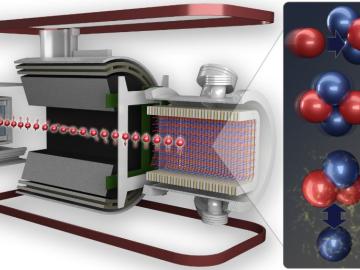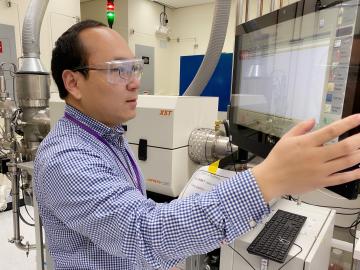
Filter News
Area of Research
- (-) Materials (70)
- Advanced Manufacturing (5)
- Biology and Environment (54)
- Biology and Soft Matter (1)
- Computational Biology (1)
- Computational Engineering (2)
- Computer Science (10)
- Electricity and Smart Grid (3)
- Energy Science (79)
- Fuel Cycle Science and Technology (1)
- Functional Materials for Energy (1)
- Fusion and Fission (34)
- Fusion Energy (11)
- Isotope Development and Production (1)
- Isotopes (27)
- Materials for Computing (2)
- Mathematics (1)
- National Security (43)
- Neutron Science (24)
- Nuclear Science and Technology (41)
- Nuclear Systems Modeling, Simulation and Validation (1)
- Quantum information Science (2)
- Sensors and Controls (1)
- Supercomputing (92)
News Topics
- (-) Artificial Intelligence (9)
- (-) Cybersecurity (4)
- (-) Frontier (3)
- (-) Grid (5)
- (-) Isotopes (13)
- (-) ITER (1)
- (-) Machine Learning (5)
- (-) Molten Salt (3)
- (-) Nuclear Energy (16)
- (-) Physics (28)
- (-) Space Exploration (2)
- 3-D Printing/Advanced Manufacturing (23)
- Advanced Reactors (4)
- Big Data (2)
- Bioenergy (11)
- Biology (4)
- Biomedical (7)
- Buildings (5)
- Chemical Sciences (32)
- Clean Water (3)
- Composites (9)
- Computer Science (17)
- Coronavirus (4)
- Critical Materials (13)
- Energy Storage (34)
- Environment (15)
- Exascale Computing (2)
- Fusion (7)
- High-Performance Computing (4)
- Irradiation (1)
- Materials (73)
- Materials Science (78)
- Mathematics (1)
- Microscopy (27)
- Nanotechnology (39)
- National Security (3)
- Neutron Science (33)
- Partnerships (11)
- Polymers (17)
- Quantum Computing (3)
- Quantum Science (11)
- Security (2)
- Simulation (1)
- Summit (2)
- Transportation (14)
Media Contacts

Geoffrey L. Greene, a professor at the University of Tennessee, Knoxville, who holds a joint appointment with ORNL, will be awarded the 2021 Tom Bonner Prize for Nuclear Physics from the American Physical Society.

Through a one-of-a-kind experiment at ORNL, nuclear physicists have precisely measured the weak interaction between protons and neutrons. The result quantifies the weak force theory as predicted by the Standard Model of Particle Physics.

About 60 years ago, scientists discovered that a certain rare earth metal-hydrogen mixture, yttrium, could be the ideal moderator to go inside small, gas-cooled nuclear reactors.

From materials science and earth system modeling to quantum information science and cybersecurity, experts in many fields run simulations and conduct experiments to collect the abundance of data necessary for scientific progress.

In the search to create materials that can withstand extreme radiation, Yanwen Zhang, a researcher at the Department of Energy’s Oak Ridge National Laboratory, says that materials scientists must think outside the box.

Scientists at the Department of Energy Manufacturing Demonstration Facility at ORNL have their eyes on the prize: the Transformational Challenge Reactor, or TCR, a microreactor built using 3D printing and other new approaches that will be up and running by 2023.

In the race to identify solutions to the COVID-19 pandemic, researchers at the Department of Energy’s Oak Ridge National Laboratory are joining the fight by applying expertise in computational science, advanced manufacturing, data science and neutron science.

Scientists at have experimentally demonstrated a novel cryogenic, or low temperature, memory cell circuit design based on coupled arrays of Josephson junctions, a technology that may be faster and more energy efficient than existing memory devices.

Students often participate in internships and receive formal training in their chosen career fields during college, but some pursue professional development opportunities even earlier.

Researchers at the Department of Energy’s Oak Ridge National Laboratory have received five 2019 R&D 100 Awards, increasing the lab’s total to 221 since the award’s inception in 1963.


